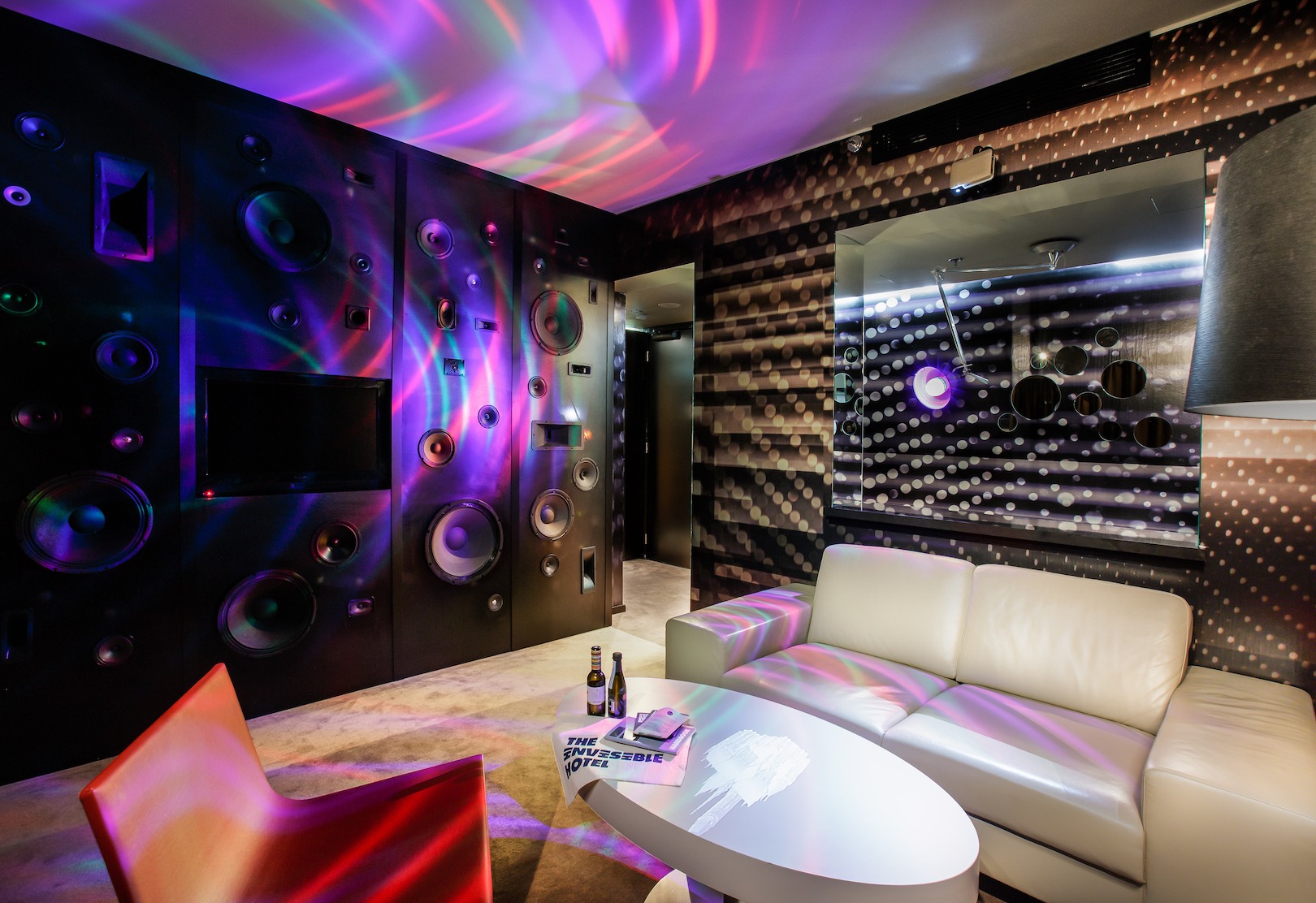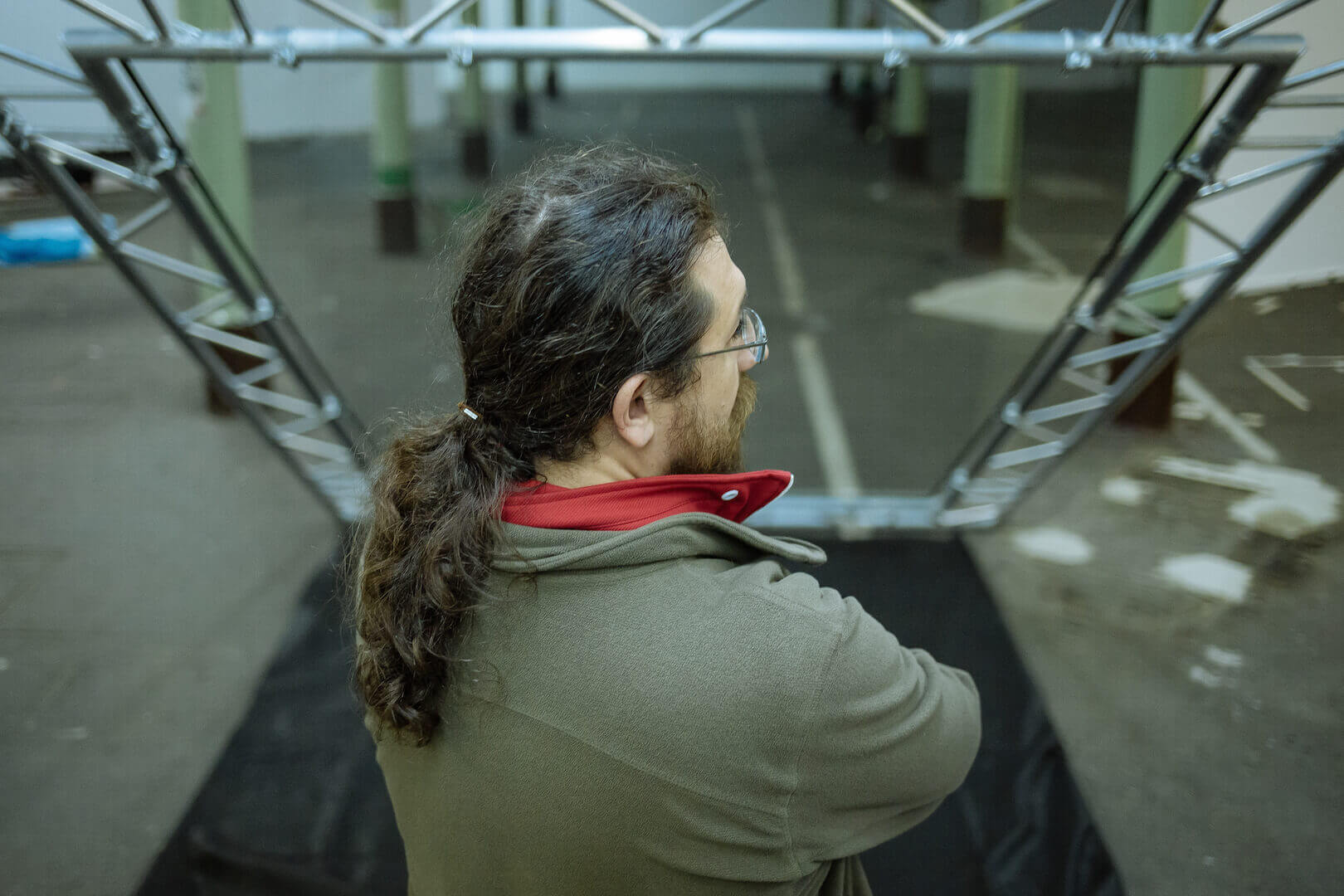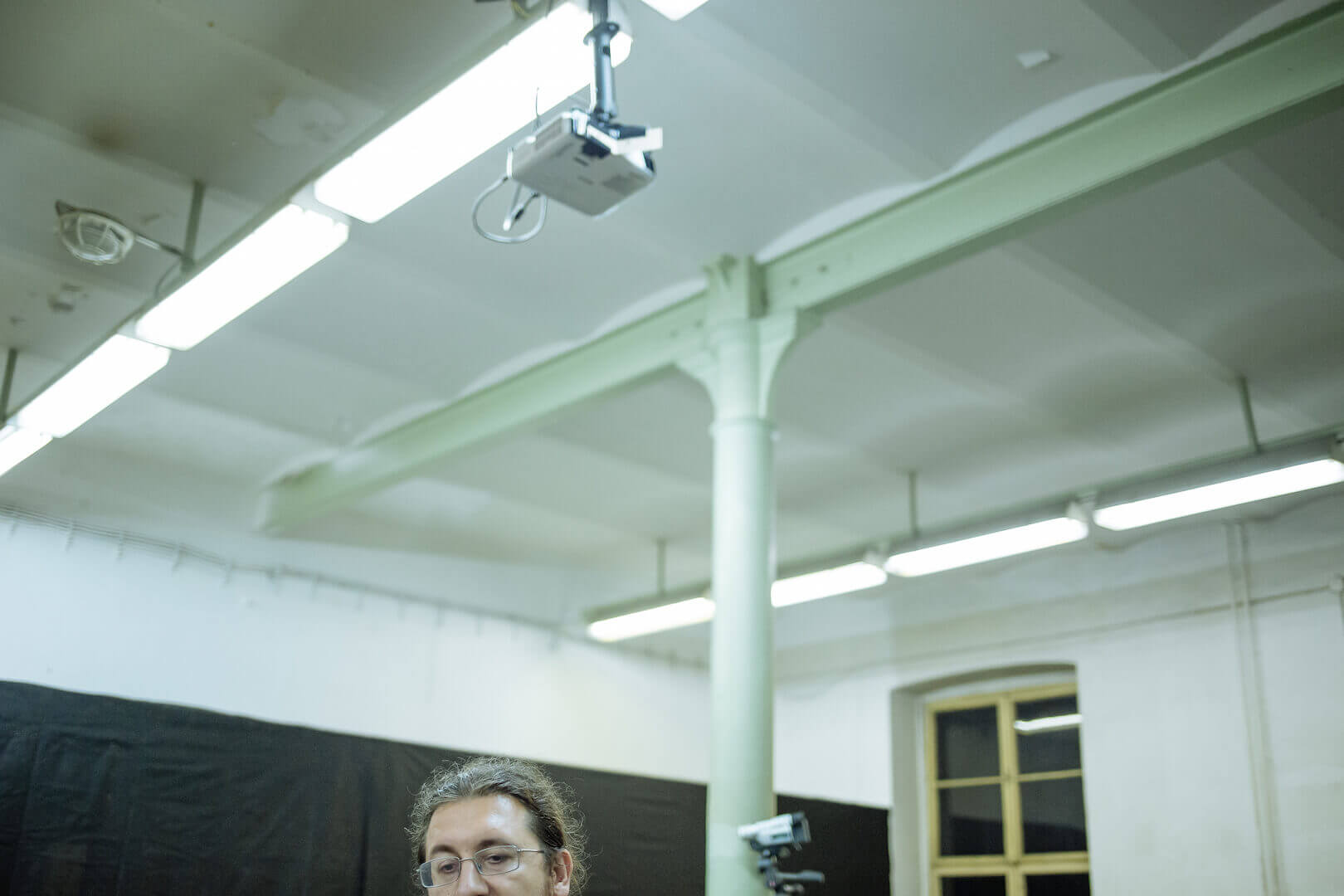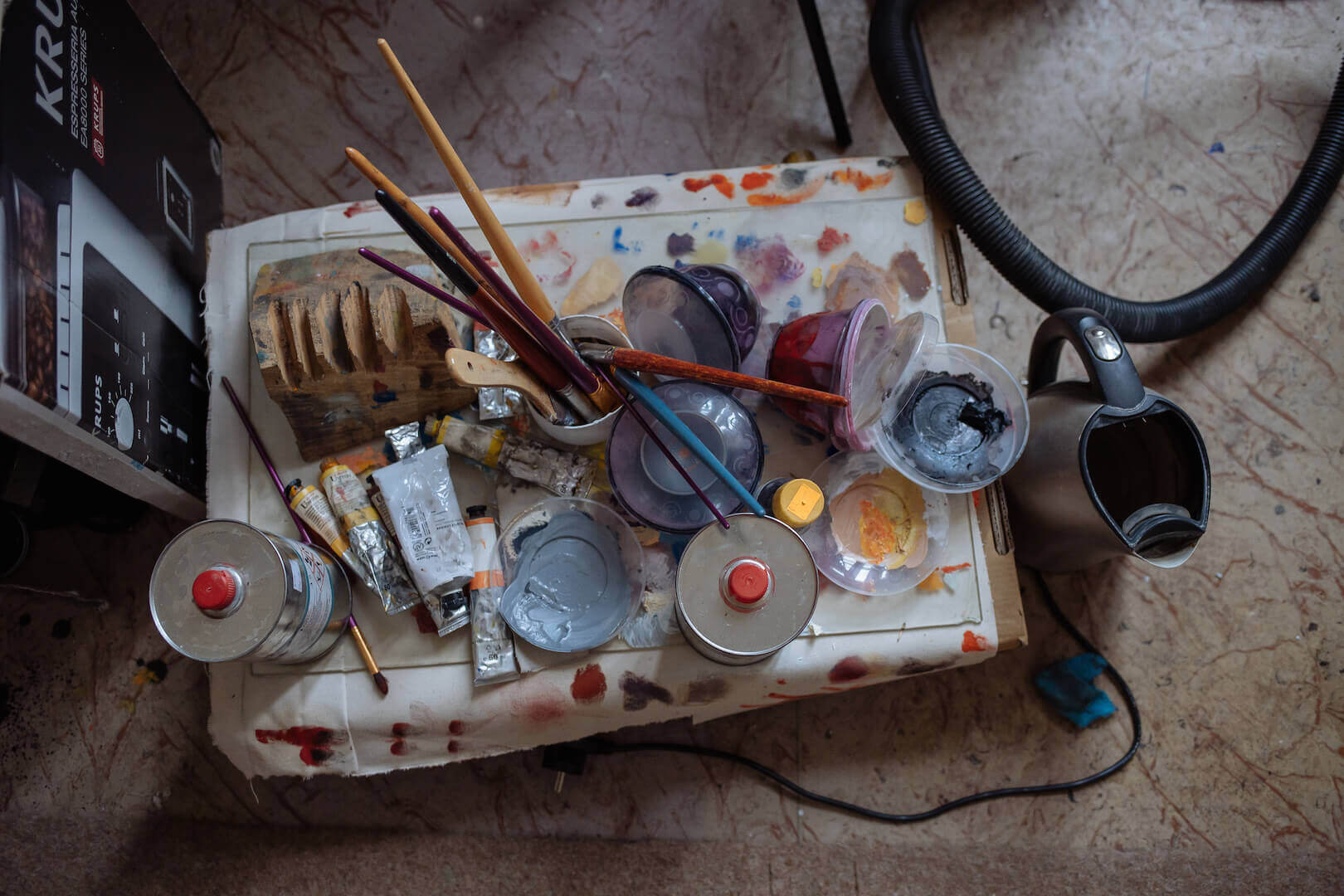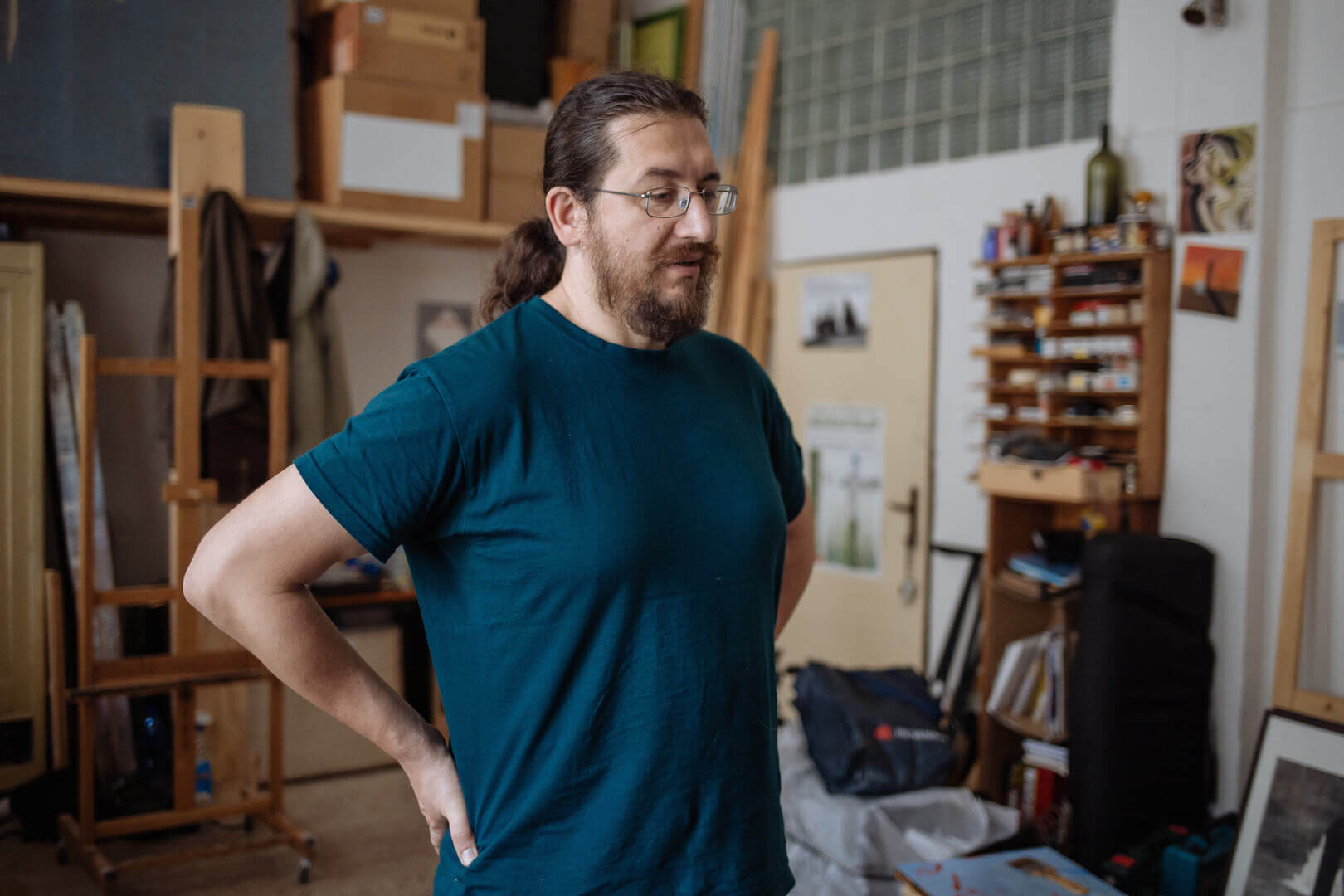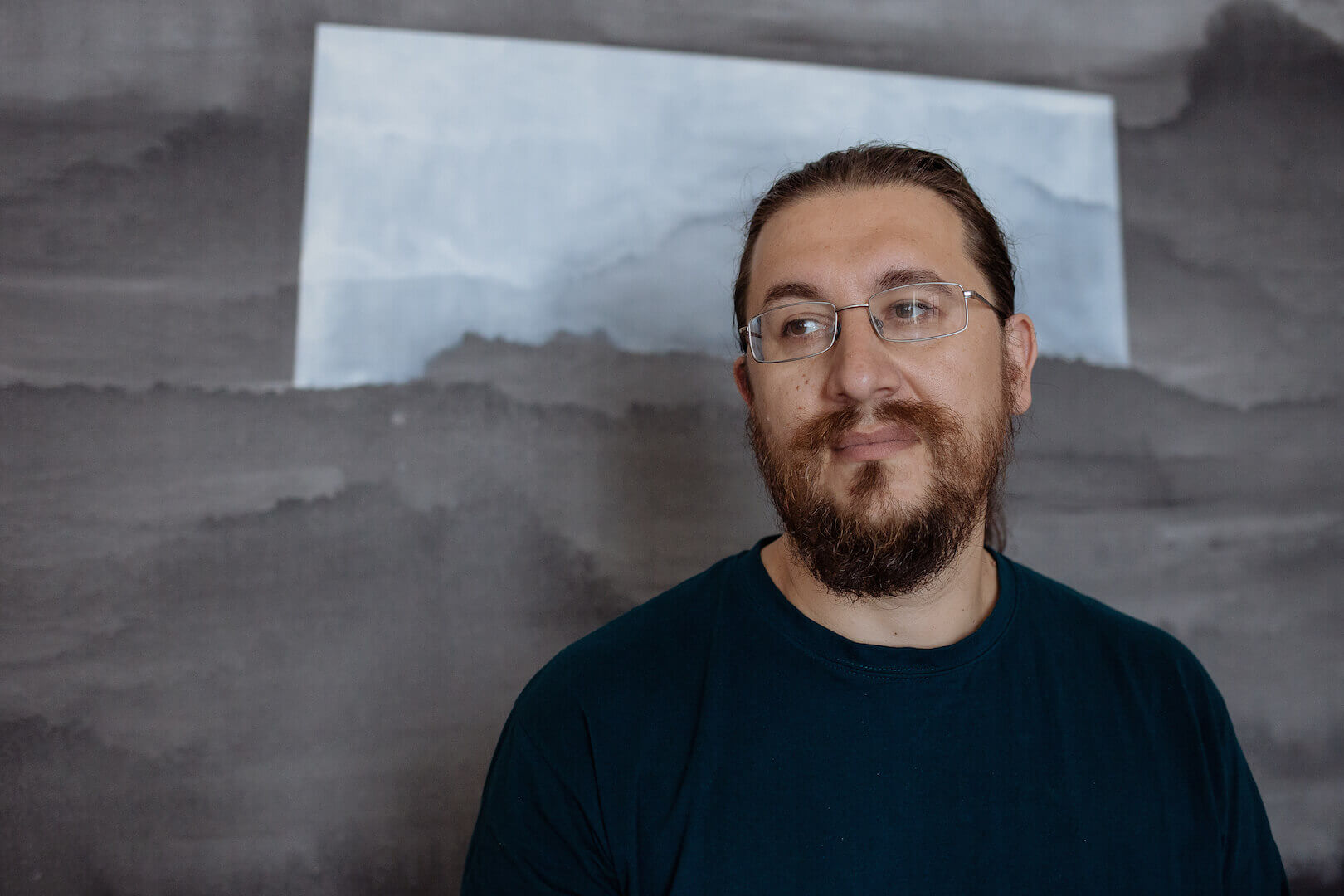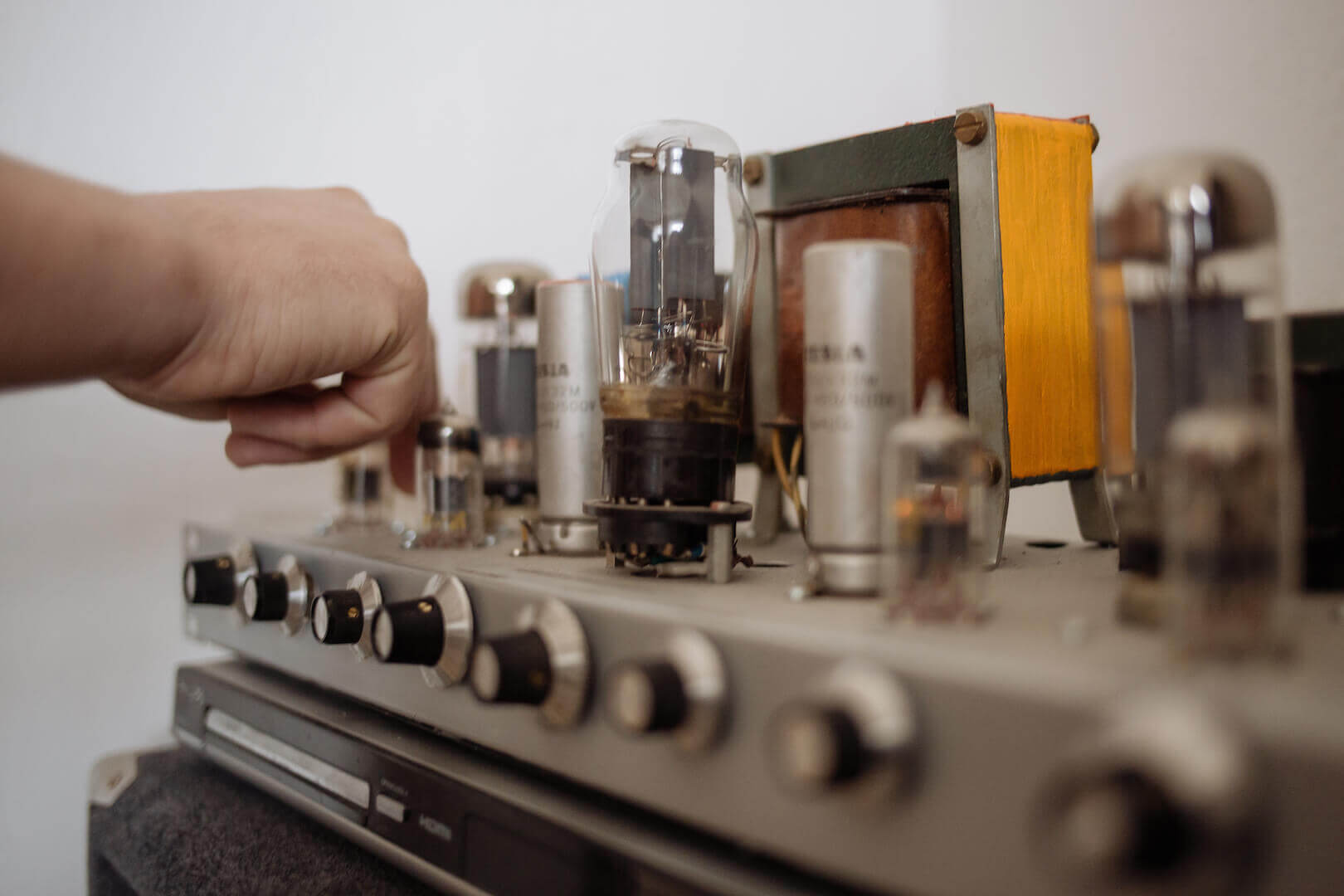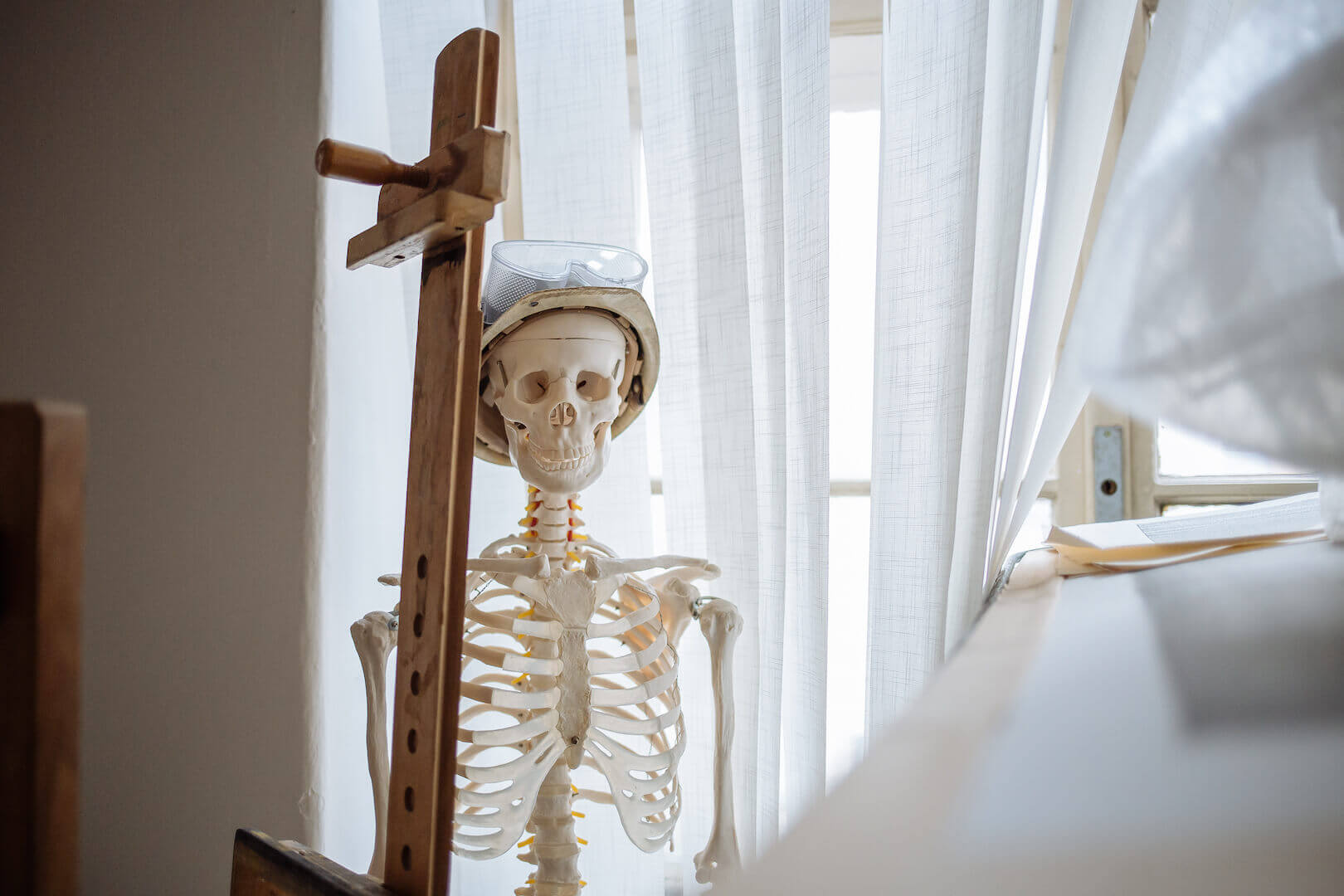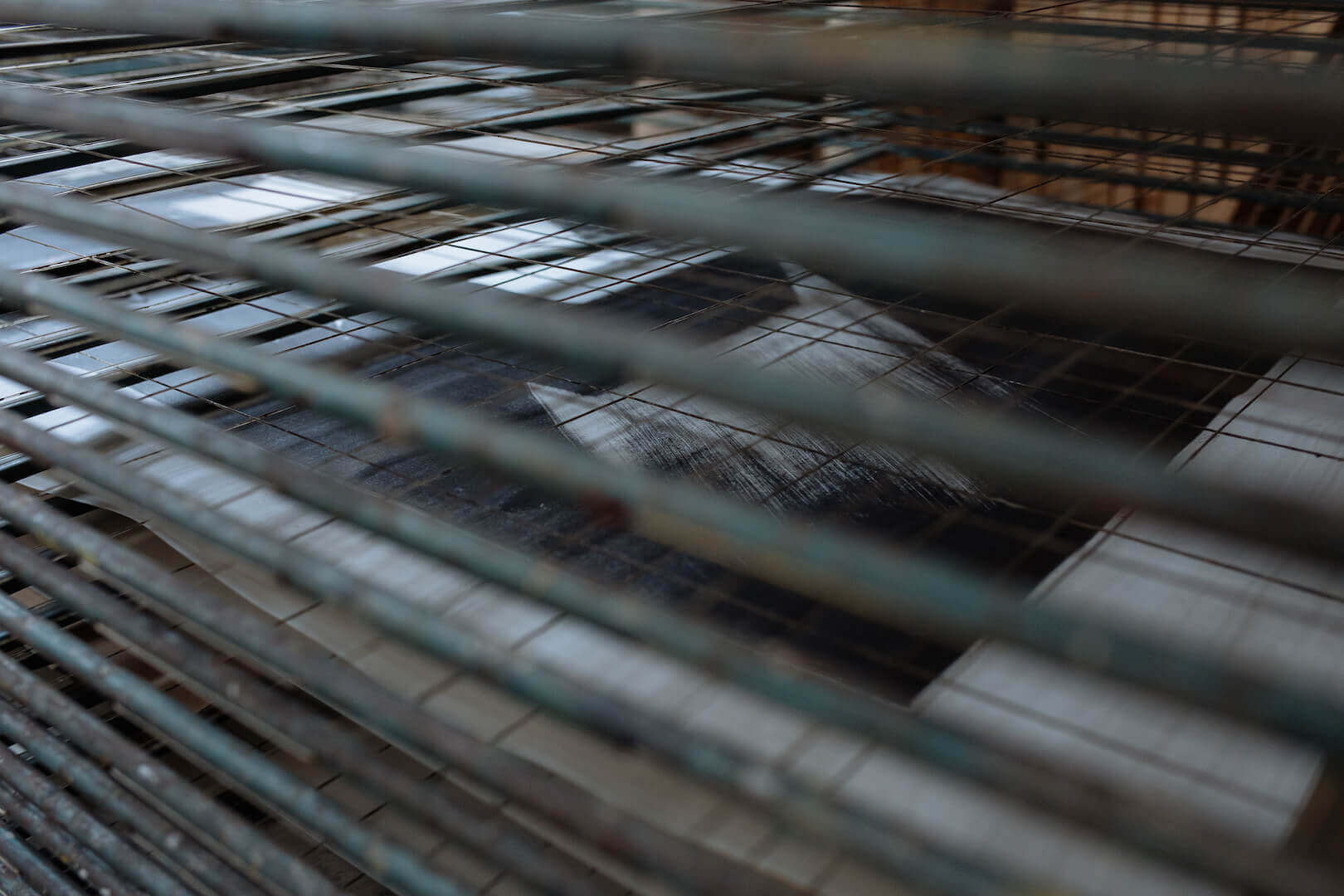What will the role of art be in the future? New media artist Boris Vaitovič
Boris Vaitovič is a multimedia artist, teacher and musician. Even though he originally wanted to focus on painting alone, he ended up venturing into the world of media and digital art. He regularly cooperates with scientists and other professionals and has recently done a residency at the University Hospital, where he worked directly with patients. We met Boris at the DIG Gallery, by an installation that he created for this year’s Nuit Blanche. He talks about the piece and the challenges that art and science will present us with in the future.
We’re standing in front of an installation you’ve created for this year’s Nuit Blanche. Tell us about it.
It’s a hologram projector, a system that integrates two-dimensional space into a three-dimensional one. It’s been a challenge for me since, as a painter, I strive for a similar result. In addition to that, this installation invites the audience to play a game. At the point where the illusion is almost perfect and they feel like they finally understand the space, I put in elements that make it disintegrate. There have been several prototypes and we’ve dealt with many issues regarding the projector itself, the reflection of light that passed through the glass and did not reflect properly. So, this installation is very far from a ready-made object and requires careful calibration. The piece measures 2×3 metres and weighs 150 kilos. It’s very heavy, fragile and difficult to manipulate with and the slightest deviation can destroy the desired visual effect.
As you’ve mentioned, you are a painter by training. Could you tell us something about your first encounters with new media?
Sure. Originally, I was only interested in painting. Becoming a painter had been my childhood dream, so I was doing everything to make it happen. Before I got into new media, I used to cut my own films recorded on VHS tapes. But I’ve always enjoyed the numeric side of things and so I decided to give it a try while focusing on painting. I’ve also always loved photography and as soon as an opportunity to make some footage came up, I took it and I’m very grateful to Dušan Zahoranský and Vlado Beskid for their support. By the time I graduated from the Faculty of Art as a painter, I’d already done several media installations and knew that my ambitions and my focus have shifted to more interactive pieces. At first, they were analogue. I started working with the theremin, a device that creates sound in response to the physical presence of the player. Later, I began using sensors — infra, USG and later Kinect.
In order to operate these devices — primarily microcontrollers and Arduino — I needed some code. Later I discovered a community in Slovakia that used the Pure Data software and I can remember first sitting down with the ‘loadbang’ manual over the Christmas of 2009 and beginning to work on my first Data Flow tests. That’s what I’ve been doing ever since and I can see that students in Košice are interested in new media as well. In fact, I’ve seen several students at the Faculty of Art find a new direction in their work, which I’m really happy about. Personally, I’m looking for new interfaces now, to use with the so-called smart devices and trying new things in Unity. Any software has its pros and cons.
Košice has recently been designated as UNESCO Creative City of Media Arts. Do you believe this city has the necessary creative potential?
In my opinion, Košice is a city filled with IT specialists and companies that are among the best in Europe as far as development and prototypisation are concerned. So the answer is yes, definitely. I’m not sure about the general public but navigation systems, trams and busses are getting better, more integrated. We are getting closer to the ‘smart cities’ concept. The spillover effect of many of the projects that started in 2013, when Košice was the European Capital of Culture, can still be seen today. Things tend to spill over into the realm of art and culture and projects that were originally not directly related to media art end up having an influence on this sphere. That’s already happened so many times that I’m sure Košice has a very solid basis for being a Creative City.
What do you think bout our potential for international cooperation?
A musical instrument I created using unicellular organisms was selected for the 10th European Researchers’ Night in Brussels. European countries chose their representatives and I ended up being one of the 31 people there. I think it shows that, in terms of science, too, there is the potential for something new, different and creative. Slovak Academy of Science has been doing cutting-edge research into space and low-temperature physics, they have extensive scientific infrastructure, laboratories and atomic force microscopes. We have everything except for CERN, which is great and Košice is definitely the right place.
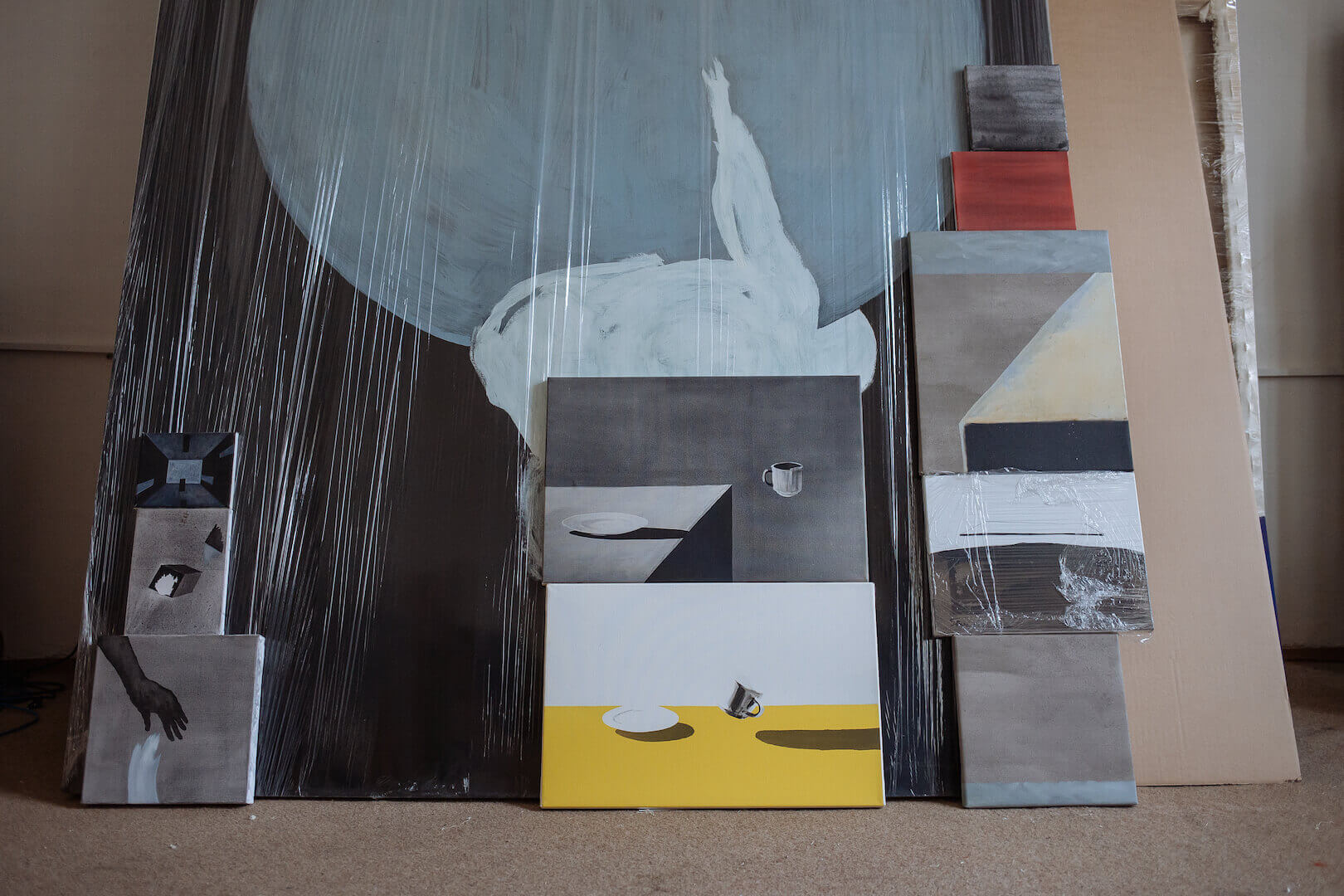
Art and science are truly two separate words, each living its own life. The challenge, however, is to make them work together, to achieve syncretism…
Syncretism is already a reality but I’d like to see more synthesis, that is, systematic combination to form a coherent whole. And that’s been happening too, even though the process might be a bit slower. Many things would’ve been impossible a couple of years ago, due to technological or commercial restrictions. An item that costs 24 euros today would have cost 150 euros four years ago and having to buy 300 pieces for a project would’ve been a problem.
We’ve recently hosted a major European conference called WIRE — Week of Innovative Regions in Europe, for which Jakub Pišek and I created responsive hardware. Each participant wore a badge — a little light that reacted to the responses they gave in their entry form and to the way they participated in the conference. There were 200 people from all over Europe who didn’t know each other but the colour of their lights, generated by the server, told them who shared similar opinions. By the colour of their badges, the participants could tell who was interested in commercial, ecological or socials aspects.
I don’t think there’s such a gap between art and science. I don’t mean to trivialise the differences by saying for instance that nanoaesthetic in itself is sufficient, that it embodies all the beauty and all that is worth commenting on visually. The possibilities are immense and I’m personally looking forward to nanostructures taking off. It’s been estimated that we need about 15 to 20 years before we can properly regulate them but in the end, it might solve all the problems with artificial organs. For artists, the world of new media is one of the great opportunities. A classical medium, such as a photograph or a painting, reminds us of something else, something that has already been created, from the moment I start working on it. That, of course, doesn’t mean it’s no longer challenging or relevant.
About a year ago, you did a residency in a hospital where you were able to work with patients. What did you create together?
I was approached by Creative Industry Košice about a project in a sphere that artists do not usually get to enter. They knew my previous work and asked me whether I’d be interested in a residency at the Physiotherapy department of the University Hospital in Košice. Naturally, I accepted and it turned out to be a very interesting experience. The beginning was a bit challenging because the hospital staff had no idea how an artist could make a contribution in a field that required specialised knowledge. I didn’t know what to expect either and had no idea what kind of patients I was about to work with. It took us about a month to discuss these issues, determine what was possible, to select a target group of patients and the movements they needed to practice. Doctor Dziaková and her staff provided me with information that enabled me to start thinking about a visual interface. As an artist, I could create something audio-visual and interactive, which is what I’m interested in and what I really wanted to do.
The longer I was there the more I became aware of the apathy of the patients, especially the older ones. They’d never used a computer and their experience with electronic devices was limited to push-button mobiles. Aware of these emotions and my own limitations, I was able to determine my priorities. I wanted to create something interesting that would draw the patients out of their apathy. It’s hard to imagine what it’s like to suffer a stroke and practically overnight lose control of an arm of a leg. The challenge that this project presented took on a social, rather than artistic significance for me. I began looking for logical connections. There were some movements for which there’d been no other rehabilitation possibilities and I decided to focus on those, on what was missing and needed. For each movement that the patients were required to do, I was looking for something similar and familiar that would give them a chance to interact with a visual or acoustic interface.
There were many complications along the way, both with hardware and the code. All the data needs to be recorded in the database so that it can be processed and presented to doctors in a comprehensive way. Patting a patient on their back wouldn’t be enough, what they need is to see the progress. I ended up creating sensors that not only show the patient’s progress on the devices that I’ve created but track their overall improvement. What matters is that the patients get well or at least better than before. It may all seem very playful and attractive but there’s a lot of math and precise calculations involved.
The hospital staff got data about their patients’ progress and the patients, at the very least, some variety in their monotonous physiotherapy routine. What did you as an artist get out of this project?
Respect for physiotherapists and their work. It’s neither easy nor pleasant and I don’t think I’d be able to step into their shoes. All of a sudden, living a normal life seemed like a luxury to me. It was also very rewarding to see the patients play, which completely changed their mood, they were no longer cranky but started to smile. What could possibly be better than making a paralyzed person smile?
There are many opinions about the role of science and technology in the future and some of them are not very optimistic when it comes to humans. What’s your opinion? Will technology save or destroy us?
I believe that, when compared to other creatures, people are not really equipped for anything. We have no claws, no fur to keep us warm, no wings to help us fly. Even though we rule ‘everything’, I don’t think we fit into any environment naturally. That’s why we have to create tools. Our hands cannot really do anything, except maybe for art and that alone wouldn’t keep us alive. We are meant to survive by using our brains, that’s why our arms and legs are the way they are, that’s why we walk upright and suffer back pain. It all shows that we don’t fit into this world and, in order to survive, we have to use our intellect. And that’s not something that can ever stop. Unlike the Na’vi from the Avatar film, we won’t reach perfection one day and live happily in harmony with the planet. We’ll have to keep moving, improving our technology along the way. It’s getting smaller and faster, we’re approaching the speed of synaptic transmission. I don’t think technology will bring about either our destruction or salvation. It’s a part of our culture, not something unnatural. What’s problematic is making a new invention before we can understand its moral or ecological implications. But I’m still optimistic about our ability to use technology not only for destruction but also to ensure stability.
How do you see the role of art in the future?
Researchers have been trying to determine what it is that sets the humans apart from other creatures. They focused on speech first but discovered that dolphins use multiple communication signals and channels. Elephants, too, communicate by trumpeting into the ground to signal they’ve reached a dry river delta. It turns out that communication in itself is not what makes us different. It’s the capacity to accumulate cultural knowledge. It means that, as a painter, I can build on art created a hundred years ago and learn from Picasso or Michelangelo. Everything is available and everything conveys a message. Books allow us to record our culture over long periods of time. Making a scientific discovery used to take generations. Today, we can absorb all the knowledge in a couple of years. The culture was born the moment people stopped seeing themselves as hungry creatures and began seeing themselves as creatures that want to leave some legacy for the next generation to build on. I’m a huge fan of culture and everything culture-related because that’s our only option. There’s never been any other option for humanity, even though we’re unable to admit it. Our future often seems to lie somewhere else but in fact, it’s always been about culture alone.
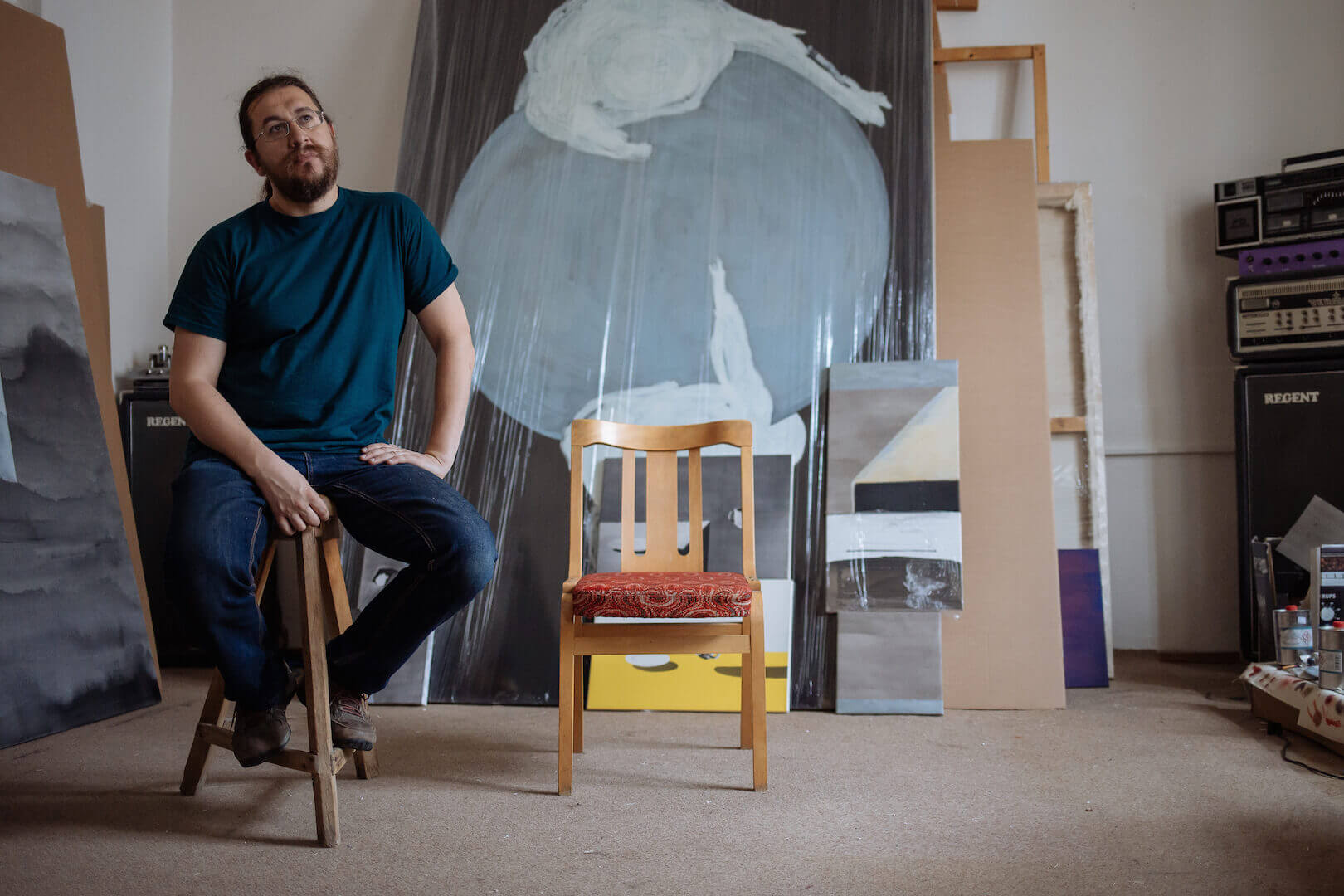
Do you want to meet Boris Vaitovič and learn more about media art, latest technologies or innovations? Visit the Art and Tech Days festival and conference. Book your room at The Invisible Hotel while staying in Košice. More at: www.atdays.sk
